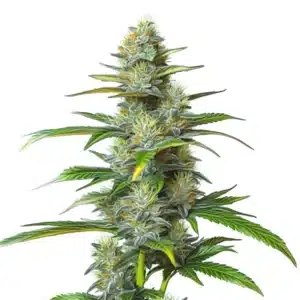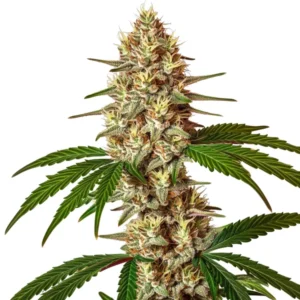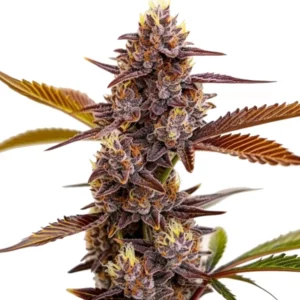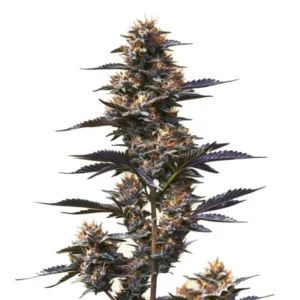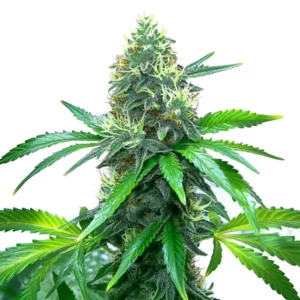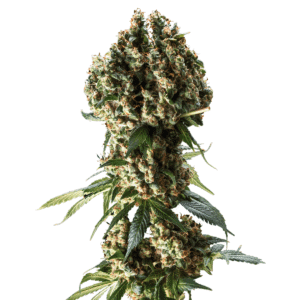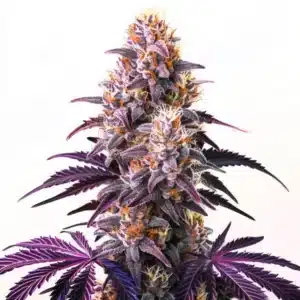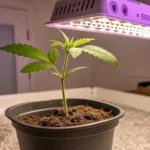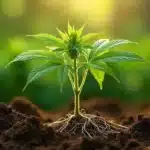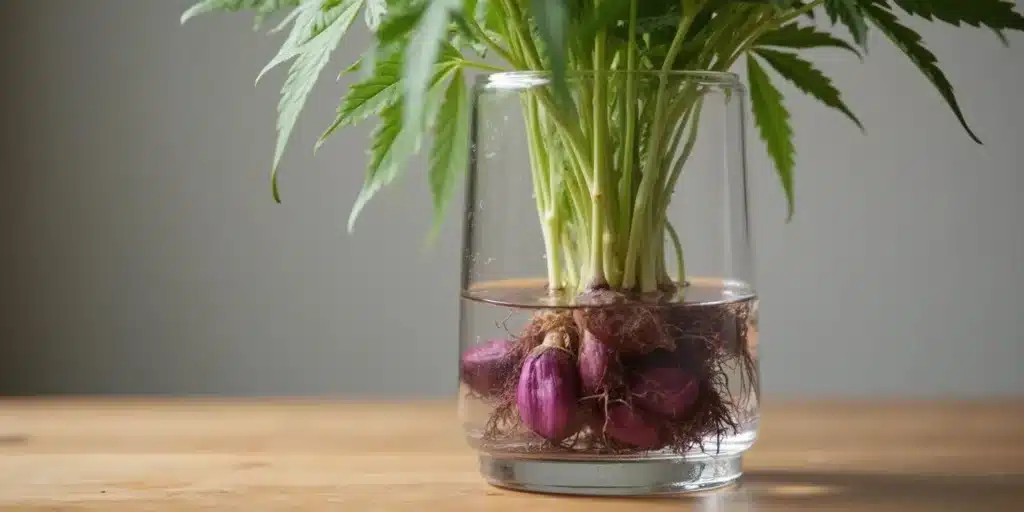
Cannabis Root Stalks Turning Purple
When growing cannabis, it’s common to notice color changes. One intriguing change is cannabis root stalks turning purple. This can be a beautiful sight, but it often leaves growers puzzled. Purple stems can occur for several reasons, and while it sometimes indicates a healthy plant, it can also signal issues that need attention.
Genetics play a significant role. Some strains naturally exhibit purple hues, like the Blue Dream strain. However, when unexpected purple stems appear, growers should consider environmental factors and nutrient levels.
Recommended Strains
Moby Dick
|
|
THC | 24% - 27% (High) |
|
|
Type | Feminized |
|
|
Yield | High |
|
|
Phenotype | 40% Indica / 60% Sativa |
Moby Dick Autoflower
|
|
THC | 16% - 20% (Medium) |
|
|
Type | Autoflowering |
|
|
Yield | Medium |
|
|
Phenotype | 40% Indica / 60% Sativa |
Reasons for Purple Cannabis Stems
There are several reasons why cannabis root stalks might turn purple. Often, it’s due to genetics. Certain strains are bred to produce purple pigments (anthocyanins). Strains like Purple Kush are a perfect example.
Temperature fluctuations can also lead to purple stems. Cooler temperatures, especially at night, can enhance the purple coloration by inhibiting chlorophyll production, allowing anthocyanins to become more prominent.
As some cannabis plants age, they naturally develop purple hues. This is not a cause for concern unless accompanied by signs of distress. Additionally, stress factors such as overwatering or inadequate light can lead to discoloration.
Nutrient Deficiencies Affecting Cannabis Color
Nutrient deficiencies can cause cannabis stems to turn purple. A lack of phosphorus is a common cause, as it is crucial for energy transfer. Another is magnesium, which is vital for chlorophyll production. Deficiencies in zinc and potassium can also contribute. To resolve these, growers should conduct soil tests and adjust fertilization practices.
Promos & Deals
Environmental Factors
Environmental factors play a crucial role in the color of cannabis stems. This starts with your soil. The initial pH of your growing medium should be between 6.0 and 7.0; it is best to avoid or amend any soil that is outside this optimal range, as it can negatively affect the roots from the beginning.
Apart from air temperature, soil temperature also heavily influences discolorations, which are more likely to occur in soil that is either too hot or too cold. Light exposure can also influence color, as intense light may cause stress.
Humidity and soil pH also affect plant color. Improper soil pH can hinder nutrient absorption. To manage this, it is vital to monitor the pH of your irrigation water. Always test the pH after adding nutrients and adjust it to around 6.0 before watering. Poor air movement can create microclimates, so ensure adequate ventilation.
Practical Tips for Growers
For growers dealing with purple stalks, several strategies can help. Start by choosing resilient strains known for their color traits, like Granddaddy Purple. Maintain consistent growing conditions by monitoring temperature, light, and humidity.
A great preventative technique is to apply a layer of mulch to your topsoil. Mulching helps maintain stable soil moisture and protects the root zone from extreme external temperature variations, reducing two of the major stress factors that can lead to discoloration.
Implementing a regular plant care routine can also prevent discoloration. Regularly pruning, watering, and feeding your plants according to their growth stage ensures they remain healthy.
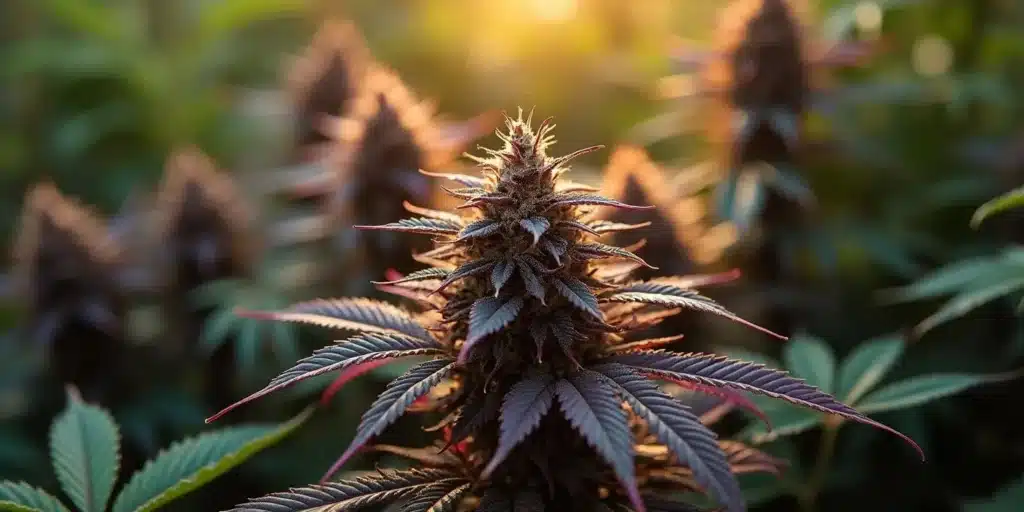
When to Be Concerned
While purple stems can be normal, it’s essential to know when they signal a problem. If they are accompanied by other symptoms like stunted growth, yellowing leaves, or wilting, it may indicate a more serious issue.
In such cases, inspect the plant thoroughly. It’s also a good idea to inspect the roots themselves. Healthy roots, even if they have some pigmentation, should always have a vibrant and shiny appearance. If the roots look pale, dull, or brown, it’s a clear sign of root rot or dryness, which is a much more serious problem than simple stem discoloration. Check for signs of pests or mold. Another sign of concern is if the purple coloration spreads rapidly, which could indicate a systemic issue like root rot.
Consulting with Experts
Sometimes, identifying the cause of purple stems requires expert advice. Consulting with experienced growers or utilizing resources from trusted seed providers like Blimburn Seeds can offer valuable insights.
Forums and grower communities are also great places to seek advice. Sharing experiences and solutions with fellow growers can provide new perspectives on managing purple stems.
Reaching out to agricultural extension services or professional horticulturists can provide scientific insights into cannabis root stalks purple causes. These experts can offer tailored guidance based on the latest research and trends.
Participating in workshops or seminars on cannabis cultivation can further enhance your understanding of plant care. These events often cover advanced topics, including managing color changes and optimizing growing conditions for healthy plants.
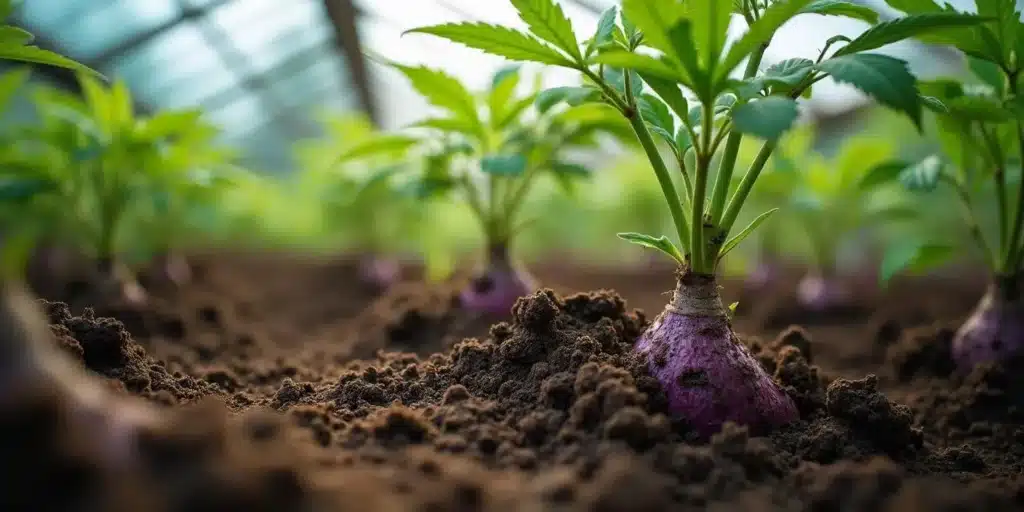
Frequently Asked Questions
Why are my cannabis root stalks turning purple?
Cannabis root stalks turning purple can be due to genetic traits, environmental factors, or nutrient deficiencies. Some strains are naturally predisposed to exhibit purple hues. However, external factors like temperature fluctuations or nutrient imbalances can also cause this change.
If the purple color appears suddenly or is accompanied by other symptoms like yellowing leaves or stunted growth, it might indicate a problem. Investigate potential stressors and adjust growing conditions accordingly to ensure plant health.
Another reason for purple stems may be related to root health. If the roots are damaged or diseased, it can affect nutrient uptake and lead to color changes. Ensuring healthy root systems is crucial for preventing discoloration.
Insufficient light penetration can also lead to cannabis root stalks turning purple. Ensuring even light distribution across the plant can help maintain uniform coloration and prevent unexpected changes.
What are the cannabis root stalks purple causes?
The primary causes of purple cannabis root stalks include genetics, temperature changes, and nutrient deficiencies. Genetics play a significant role, with certain strains naturally developing purple hues. Temperature fluctuations, especially cooler nights, can enhance pigmentation.
Nutrient deficiencies, particularly in phosphorus and magnesium, can also lead to purple stems. Ensuring a balanced nutrient supply can prevent such discoloration. Regularly monitor and adjust nutrient intake to maintain healthy plant growth.
Stress from pest infestations can also be a cause of purple stems in cannabis plants. Pests can damage plant tissues, causing stress and discoloration. Regular pest management can mitigate this risk.
Water quality is another factor. Hard water or water with high mineral content can affect nutrient absorption and contribute to discoloration. Using filtered or properly adjusted water can prevent these issues.
Are purple stems in cannabis plants always a bad sign?
Not necessarily. Purple stems in cannabis plants can be a natural trait of specific strains. If your plant is otherwise healthy, with no signs of stress or nutrient deficiency, the purple hue may simply be a genetic characteristic.
However, if purple stems are accompanied by other concerning symptoms, it may indicate an issue that needs addressing. Monitor your plants closely and ensure they receive proper care to prevent potential problems.
In some cases, purple stems can enhance the aesthetic appeal of the plant, especially for strains bred for their vibrant colors. These plants may attract more interest from growers and consumers alike.
It’s important to understand the context of the color change. If it aligns with known genetic traits and environmental conditions, it may not be a cause for concern. Always consider the overall health of the plant when evaluating color changes.
How can I find cannabis stalk discoloration solutions?
Finding solutions for cannabis stalk discoloration involves identifying the root cause. Start by assessing environmental conditions and nutrient levels. Adjust temperature, humidity, and light exposure to optimal levels.
Ensure your plants receive a balanced diet of nutrients, focusing on phosphorus and magnesium. Consulting with experienced growers and utilizing resources from reputable seed providers like Blimburn Seeds can also offer guidance and solutions.
Implementing a comprehensive care plan that includes regular monitoring and maintenance can prevent issues. This includes checking for pests, adjusting watering schedules, and ensuring proper airflow around plants.
Using technology such as soil sensors and climate controllers can provide real-time data to help manage growing conditions effectively. These tools can offer precise control over the factors contributing to cannabis root stalks turning purple.
Can nutrient deficiencies affecting cannabis color be easily fixed?
Yes, nutrient deficiencies affecting cannabis color can often be corrected with proper care. Identify the specific deficiency, such as phosphorus or magnesium, and adjust the nutrient mix accordingly. Using high-quality fertilizers can help restore balance.
Regularly monitor soil and water pH levels to ensure nutrients are readily available for uptake. By maintaining optimal growing conditions and nutrient balance, you can address and prevent deficiencies effectively.
Incorporating organic matter into the soil can improve nutrient availability and support healthy plant growth. Compost or worm castings can be excellent additions to enhance soil fertility.
Additionally, foliar feeding can provide a quick nutrient boost, particularly for addressing deficiencies. This method allows nutrients to be absorbed directly through the leaves, offering a rapid response to discoloration issues.



